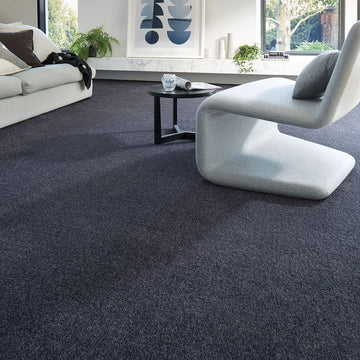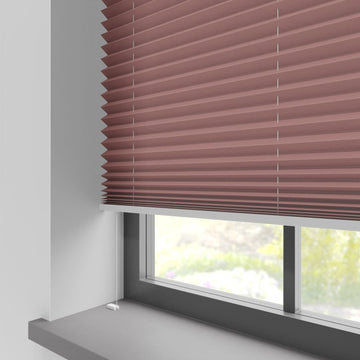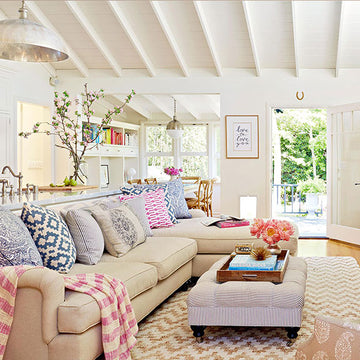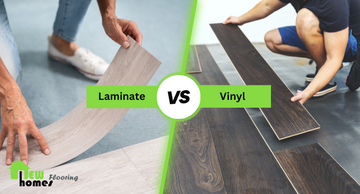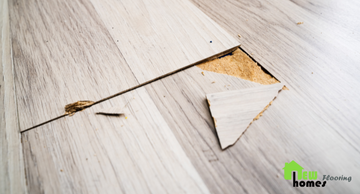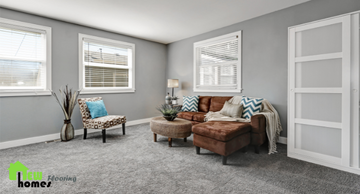In the fiercely competitive UK property market, standing out is more than a goal—it's a necessity. Choosing the right flooring might seem a minor detail, but it can be a game-changer in distinguishing your development. Many mistake laminate and vinyl flooring as identical twins. However, the past two decades have sharply defined their unique characteristics, particularly with the advent of Luxury Vinyl Tiles (LVT).
While the allure of aesthetics and the practicality of cost are influential, the subtleties between laminate and vinyl can drive your project's success. This guide explores eight vital facets of these flooring types, empowering you to make a decision that resonates with both value and quality for your next venture.
Look & Style
Both laminate and vinyl flooring have evolved, offering a plethora of stylish options that mimic natural materials like wood and stone, often at a fraction of the cost. The advanced 3D printing technology used in their production allows for an extensive range of designs, textures, and colors.
While laminate offers a realistic wood-like appearance, vinyl flooring extends a diverse style portfolio, including options that replicate stone and ceramic. The choice ultimately hinges on the specific aesthetic you envision for your properties.
Durability & Stability
Durability and stability are paramount for flooring in property development, significantly influenced by the expected use of the property. Laminate, known for its hardness and crafted from high-density fiberboard, presents a respectable durability but falls short when exposed to moisture, limiting its suitability in high-traffic areas or spaces where spills and humidity are a norm. Conversely, premium vinyl, with its hard, closed-cell structure, champions in water resistance, standing strong in moisture-prone environments.
Moreover, vinyl's resilience against daily wear and tear, coupled with its ease of maintenance, earmarks it as the go-to choice for commercial properties and rental units, where high footfall and minimal maintenance downtime are crucial. While both materials boast durability, their longevity can be swayed by factors like foot traffic, maintenance, and environmental conditions. For developers, aligning the material choice with the property’s anticipated usage is not just wise—it's essential for ensuring lasting appeal and functionality.

Moisture Resistance
In areas susceptible to spills, humidity, or high moisture, the choice of flooring isn't just about aesthetics—it's about longevity and maintenance too. Laminate, while visually appealing, falls short in environments with elevated moisture levels. Even small amounts of water seeping between the planks can be detrimental. Over time, moisture can cause laminate flooring to warp, swell, and buckle, compromising not only the floor's appearance but also its structural integrity. The protective layer can only guard against spills for a short time, urging for immediate cleanup; prolonged exposure is an invitation for damage.
In stark contrast, vinyl flooring exhibits stellar performance in moisture-laden environments. Its water-resistant properties extend from the surface to the backing, providing a comprehensive shield against moisture-related issues. This makes vinyl an unparalleled option for developments like bathrooms, basements, or kitchens, where spills and humidity are part and parcel of daily operations. In the battle against moisture, vinyl emerges as the undisputed champion.
Cost Implications and Installation Requirements
Cost analysis in flooring extends beyond the initial purchase and installation expenses, delving into realms of longevity, maintenance, and even the condition of the base slab upon which your choice of flooring will rest. Laminate, with its enticing affordability, holds appeal but carries hidden costs. Its vulnerability to moisture can lead to premature damage and replacement, incurring higher long-term expenses. Conversely, premium vinyl, while potentially pricier upfront, counters with formidable durability, low upkeep demands, and an accommodating nature towards subfloor imperfections.
When it comes to installation, the devil is in the details — specifically, the condition of the subfloor. Laminate flooring can forgive minor discrepancies, allowing installation over existing tiles, but demands the floor be level within a strict tolerance of 3mm per square metre. Achieving this often requires the use of a screed to ensure the subfloor's evenness. Vinyl plank flooring, on the other hand, offers a bit more leniency. Subfloor unevenness must not exceed 3/16 inch over a 10-foot span, or 1/8 inch over a 6-foot radius, and slopes must not surpass ½ inch per 6 feet. Despite this, the subfloor must be structurally sound, free of excessive moisture, and thoroughly cleaned prior to installation.
This meticulous preparation, while seemingly daunting, serves to ensure your flooring — be it laminate or vinyl — lives up to its fullest potential in both lifespan and aesthetics, ultimately presenting a cost-effective solution in the grand scheme of property development.
This addition underscores the importance of proper subfloor preparation and highlights the differences between laminate and vinyl in this regard, providing property developers with detailed insights for informed decision-making.
Application & Installation
The practicalities of flooring installation are often as pivotal as the material characteristics themselves, directly impacting project timelines, labor costs, and even future adaptability of the space. Laminate flooring, with its click-and-lock design, is synonymous with ease of installation, significantly reducing the time and professional labor typically associated with such tasks. However, its suitability is optimized in climate-controlled, low-moisture areas, predominantly residential spaces or commercial areas with moderate foot traffic.
Vinyl flooring, on the other hand, presents a compelling case for a broader spectrum of applications. Its ability to withstand heavier foot traffic and higher moisture levels makes it a favorite for commercial spaces, rental properties, and multi-use residential areas. Furthermore, the option for glue-down or loose-lay installation methods adds a layer of convenience and adaptability, allowing for expedited project timelines and flexibility in future space redesigns.
In this realm, the decision between laminate and vinyl transcends material costs and aesthetics, delving into considerations of installation logistics, project duration, and the intended function of each space within the property.
Environmental Impact
Sustainability is increasingly influencing decision-making in property development. Laminate is primarily made from recycled hardwood, but its moisture-related shortcomings may lead to frequent replacements. Vinyl, while not as easily recycled, boasts a longer lifespan and requires less frequent replacement, potentially reducing its environmental footprint.
Conclusion: Making the Right Choice for Your Development (approx. 100 words)
The laminate versus vinyl debate doesn't have a one-size-fits-all answer. The best choice for your next property development hinges on a balanced consideration of aesthetics, durability, cost, application, and environmental impact. By understanding the strengths and limitations of each flooring type, you can align your selection with your project’s specific needs and long-term goals.
Navigating the complexities of flooring options shouldn't be a solitary journey. Consult with our experts at New Homes Flooring to gain tailored insights and solutions for your next big project. With a comprehensive range of products and a commitment to your project's success, we're here to ensure your flooring choice enhances your property's value and appeal for years to come. Contact us today!

